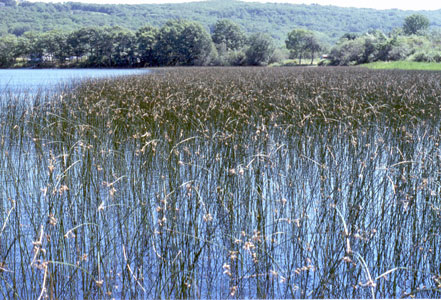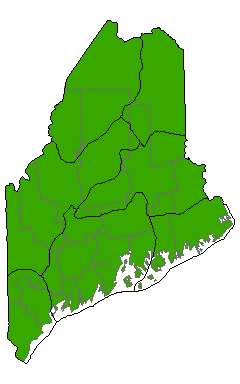DACF Home → Bureaus & Programs → Maine Natural Areas Program → Communities, Plants, and Animals → Natural Community Fact Sheets → Bulrush Marsh
Printer Friendly Fact Sheet - 1.5 MB pdf (Get a free copy of Adobe Acrobat Reader)
Bulrush Marsh
Scientific Name: Bulrush Bed; State Rank: S4

- Community Description
- Soil and Site Characteristics
- Diagnostics
- Similar Types
- Conservation, Wildlife and Management Considerations
- Distribution
- Characteristic Plants
- Associated Rare Plants
- Associated Rare Animals
- Examples on Conservation Lands You Can Visit
Community Description: Tall rushes and other non-persistent graminoids dominate this lakeshore or rivershore community. Hardstem bulrush, softstem bulrush, chair-maker's rush, and bayonet rush are common dominants. Aquatic macrophytes such as pickerelweed, pondweeds, and water-lilies may be present, but are not usually abundant. Species richness is often low. Back to top.
Soil and Site Characteristics: These deepwater marshes have standing water over 15 cm deep all year, except during unusually prolonged low water levels. Bulrush beds are often near inlets and outlets of lakes or along slow moving portions of larger streams and rivers. Back to top.
Diagnostics: This type is distinguished by a dominance of tall bulrushes and rushes to the exclusion of most other species. Standing water is present through most or all of season. Back to top.
Similar Types: Pickerelweed Marsh vegetation can share species but is dominated by pickerelweed and floating leaved macrophytes (water-lilies, pondweeds, etc.). Open-water Marsh vegetation has few emergent plants. Freshwater Tidal Marshes and Brackish Tidal Marshes may share some of the bulrush species, but occur in tidal situations and have different associated species. Back to top.
Conservation, Wildlife and Management Considerations: This type appears to be well distributed and secure in Maine. Anecdotal information indicates that the waters of numerous public lands and private conservation lands include these marshes. Maintaining appropriate wetland buffers can help ensure that adjacent land uses do not result in degradation.
These deep emergent marshes provide foraging and nesting habitat for a large number of wading birds and waterfowl including rare species such as the least bittern, common moorhen, and American coot. They also offer excellent habitat for a number of insects including the New England bluet, pine barrens bluet, the rare scarlet bluet, and the rare citrine forktail. Back to top.
Distribution: Statewide, although not well documented. Extends southward and westward from Maine, and presumably into Canada. Landscape Pattern: Small Patch. Back to top.


Characteristic Plants: These plants are frequently found in this community type. Those with an asterisk are often diagnostic of this community.
- Herb
- Bayonet rush*
- Chair-maker's rush*
- Hardstem bulrush*
- Softstem bulrush*
There are no documented rare plants associated with this natural community.
- American coot
- Black-crowned night heron
- Citrine forktail
- Common moorhen
- Least bittern
- Scarlet bluet
Examples on Conservation Lands You Can Visit
| Example | County |
|---|---|
| Acadia National Park | Hancock Co. |